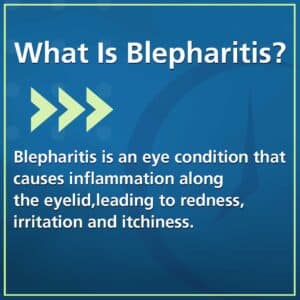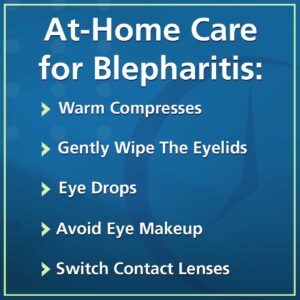
Blepharitis
If your eyelids are swollen, red or persistently itchy, you may be dealing with blepharitis. This common eye condition affects the skin around the eyes and can cause significant discomfort.
Whether it’s the outer edges of your eyelids (anterior blepharitis) or the inner eyelid (posterior blepharitis), it’s important to understand the symptoms, causes and treatment options so you can find relief. The good news? There are simple at-home care routines and effective treatments available.
What Is Blepharitis?

Anterior Blepharitis
Anterior blepharitis affects the outer edge of your eyelids near your eyelashes. It’s often caused by staphylococcal bacteria or seborrheic dermatitis, which leads to greasy flakes, swollen eyelids and irritation. Keeping your eyelids clean with warm water and diluted baby shampoo can help prevent this buildup. Some alternative treatments, including specially-formulated eyelid scrubs and sprays.
Posterior Blepharitis
This type affects the inner eyelid where the meibomian glands are located. When these glands get clogged, it can cause meibomian gland dysfunction, which leads to symptoms like excessive tearing and discomfort, especially if you wear contact lenses. Treatment often involves using warm compresses, massaging the eyelid and using artificial tears to lubricate the eyes.
If left untreated blepharitis can cause more serious issues like misdirected eyelashes, sensitivity to light, or even missing lashes. That’s why regular eye exams are key to managing the condition.
What Causes Blepharitis?
Blepharitis can stem from a number of different factors, which include bacterial infections, gland dysfunction and external irritants.
Bacterial Infections & Skin Conditions
The most common causes of blepharitis include an overgrowth of staphylococcal bacteria, leading to irritation and the development of flaky debris on the eyelids. Seborrheic dermatitis, a skin condition that causes oily, scaly patches can also lead to inflammation and discomfort.
Meibomian Gland Dysfunction
In some cases the meibomian glands (the oil-producing glands inside the eyelids) can become blocked, leading to posterior blepharitis. This can cause symptoms such as dry eyes, excessive tearing and light sensitivity.
Poor Eyelid Hygiene & External Irritants
Another major factor is poor eyelid hygiene. Not properly cleaning your eyelids, leaving eye makeup on overnight, or frequent exposure to dust and smoke can also contribute to irritation and increase the likelihood of developing blepharitis. People who wear contact lenses for extended periods may also be more prone to the condition.
Since blepharitis cases often recur, managing symptoms requires a consistent care routine, including gently scrubbing the lids, artificial tears and, in more severe cases, prescription eye drops or oral medication.
Factors That Increase the Risk of Blepharitis
Some people are more prone to blepharitis due to underlying conditions, lifestyle choices or environmental exposure. Some of these risk factors include:
Skin & Eye Conditions
People with dermatitis, rosacea, or oily skin are more prone to developing blepharitis. Those with dry eyes or gland dysfunction may experience more severe symptoms.
Contact Lens Use & Eye Hygiene
Wearing contact lenses for extended periods, improper lens hygiene, or not removing eye makeup fully can lead to bacterial buildup and eyelid irritation.
Gland Dysfunction & Bacterial Imbalance
Blocked meibomian glands can cause discomfort, while staphylococcal bacteria can lead to infections, making symptoms worse.
Environmental & Lifestyle Triggers
Exposure to dust, bright light, wind or allergens can worsen blepharitis symptoms. A poor diet, dehydration, and excessive screen time may also impact tear production and eyelid health.
Aging & Chronic Conditions
As we age, our tear production naturally declines, which can lead to more frequent irritation. People with autoimmune diseases are also at greater risk for persistent symptoms.
Prevention & Management

Symptoms of Blepharitis
The symptoms of blepharitis can vary from mild irritation to more serious discomfort, often affecting daily activities. Common symptoms include:
- Persistent itching or irritation around the eyes
- Swollen eyelids, which can make blinking uncomfortable
- A buildup of greasy flakes near the base of the eyelashes
- Redness and inflammation of the eyelid margins
- A gritty or burning sensation, especially in dry environments
- Excessive tearing or dry eyes
- Crusting around the eyelids, particularly in the morning
In more severe cases, blepharitis can cause chronic irritation or even misdirected eyelashes. It’s important to see an eye specialist if you notice persistent symptoms to avoid complications and get proper treatment.
How an Eye Doctor Diagnoses Blepharitis
A comprehensive eye exam is essential for identifying blepharitis and determining the most effective treatment plan. Eye doctors assess inflammation, tear quality and gland function to pinpoint the cause of irritation.
Evaluation Process
During the examination, the doctor will:
- Inspect the eyelids for oily debris, flaking or swelling
- Check the base of your eyelashes for blocked oil glands or eyelid skin irritation
- Use a slit lamp microscope to examine tear production and gland dysfunction
If an infection or underlying skin condition is suspected, additional tests may be conducted:
- Gland Function Assessment: Light pressure on the lids reveals any blockages in the meibomian glands.
- Bacterial Culture: A sample from the inner edge of the eyelid may be analyzed if an infection is present.
- Tear Analysis: Determines if dryness is affecting eye health
Early detection helps prevent blepharitis complications including inflamed eyelids and abnormal lash growth. It’s important to get regular checkups to support long-term symptom management and reduce flare-ups.
Treatments for Blepharitis
Managing blepharitis requires a combination of daily eyelid care, home remedies and, in some cases, medical treatment. Since blepharitis often recurs, consistency is key in keeping flare-ups under control.
At-Home Care for Blepharitis

- Warm Compresses: Applying a warm cloth to your eyelids helps loosen and unclog oil glands.
- Eyelid Cleaning: Use diluted baby shampoo or a specialized eyelid cleanser to gently clean your eyelids. You can use a cotton swab or your sanitized fingers to wipe away any debris.
- Artificial Tears: Over-the-counter lubricating eye drops can help relieve dryness and discomfort.
- Avoid Eye Makeup: Reducing the use of makeup helps prevent further irritation.
- Switch to Glasses: If you wear contact lenses, consider switching to glasses to give your eyes a break and reduce irritation.
Medical Treatments
For more severe cases or persistent symptoms, your eye doctor may recommend additional treatments. These may include:
- Antibiotic Drops or Antibiotic Ointment: These can treat bacterial overgrowth and help reduce inflammation.
- Oral Antibiotic: In cases of chronic inflammation, your doctor may prescribe medication to reduce symptoms.
When To See an Eye Specialist

Early diagnosis and proper blepharitis treatment can help manage symptoms and prevent complications. Regular eye exams and cleanings can help keep the eyelids clean and reduce blepharitis flare-ups.
Contact Tower Clock Eye Center for Blepharitis Care
If you’re experiencing symptoms like itchy, red, or swollen eyelids, the doctors at Tower Clock Eye Center can help you find relief. We offer personalized care tailored to your needs and will work with you to manage your symptoms effectively.
Schedule an eye exam today to begin your journey toward clearer, more comfortable vision. Call us at (920) 499-3102 to book your appointment!
